The global radiotherapy market is estimated to be valued at USD 8.55 Bn in 2025 and is expected to reach USD 14.01 Bn by 2032, exhibiting a compound annual growth rate (CAGR) of 7.3% from 2025 to 2032.
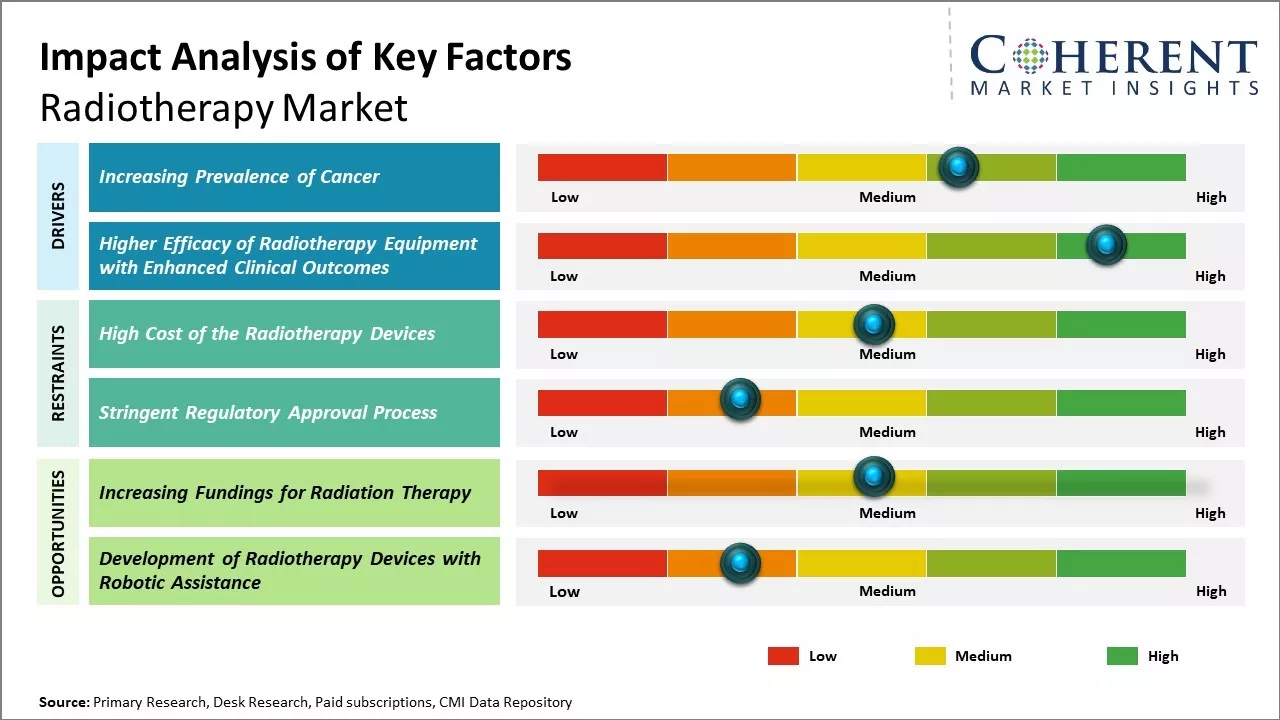
Discover market dynamics shaping the industry: Request sample copy
The increasing prevalence of cancer around the world is the key factor driving the demand for radiotherapy. As per World Health Organization, cancer accounted for nearly 10 million deaths in 2020 and is one of the leading causes of mortality worldwide. Additionally, rising adoption of advanced treatment techniques, such as intensity-modulated radiation therapy (IMRT) and stereotactic body radiation therapy (SBRT), is also boosting the growth of the radiotherapy market. Furthermore, growing awareness about the therapeutic advantages of radiotherapy compared to other cancer treatment options is augmenting the market expansion.
Market Driver – Increasing Prevalence of Cancer
Rising prevalence of oncology diseases, such as prostate cancer, lung cancer, and breast cancer, globally is increasing the demand for timely management to reduce mortality associated with such conditions. This, in turn, is a major factor augmenting the growth of the radiotherapy market. For instance, according to data provided by Breastcancer.org, in March 2022, an estimated 287,850 new cases of invasive breast cancer are expected to be diagnosed in women in the U.S., along with 51,400 new cases of non-invasive (in situ) breast cancer in 2022.
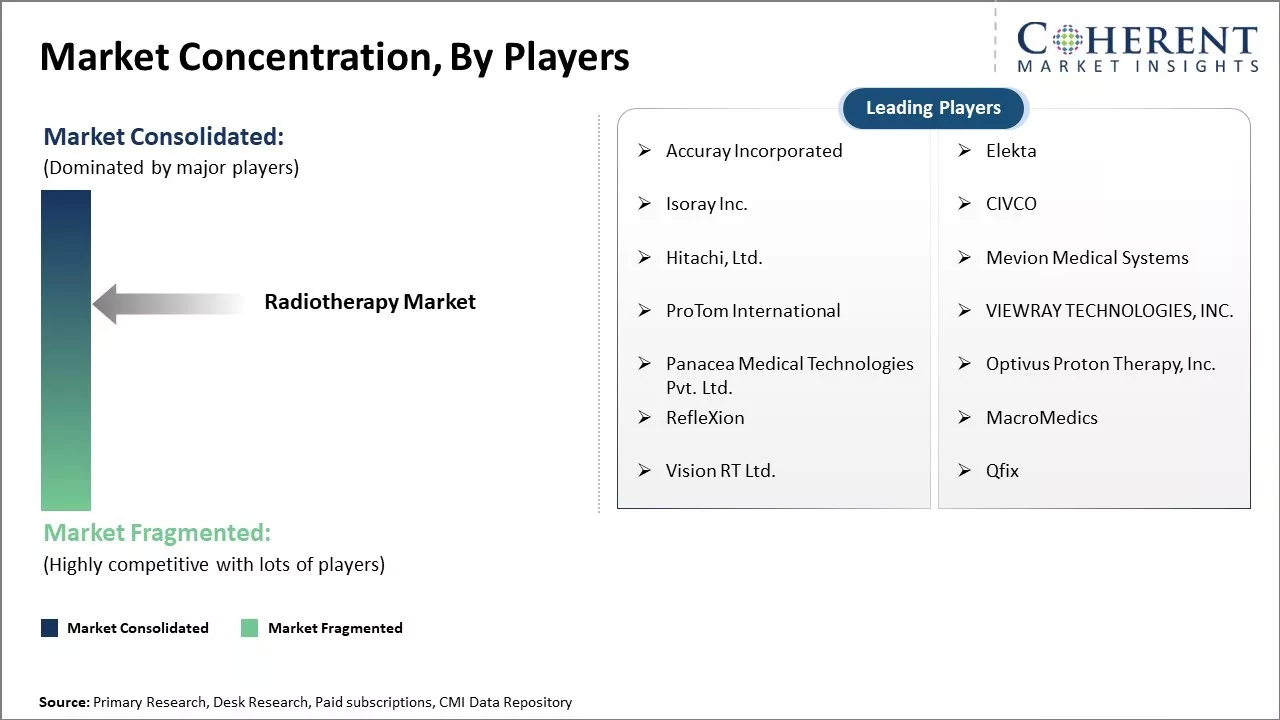
Get actionable strategies to beat competition: Request sample copy
Higher Efficacy of Radiotherapy Equipment with Enhanced Clinical OutcomesThe high-energy radiation used during radiotherapy permanently damages the DNA of cancer cells, causing them to die. According to the data provided by Mayo Foundation for Medical Education and Research (MFMER), in July 2020, almost half of all people with cancer have radiotherapy as part of their treatment plan. Moreover, according to the data published by NHS inform, in November 2021, four out of every 10 cancer cures include radiotherapy as part of the treatment plan.
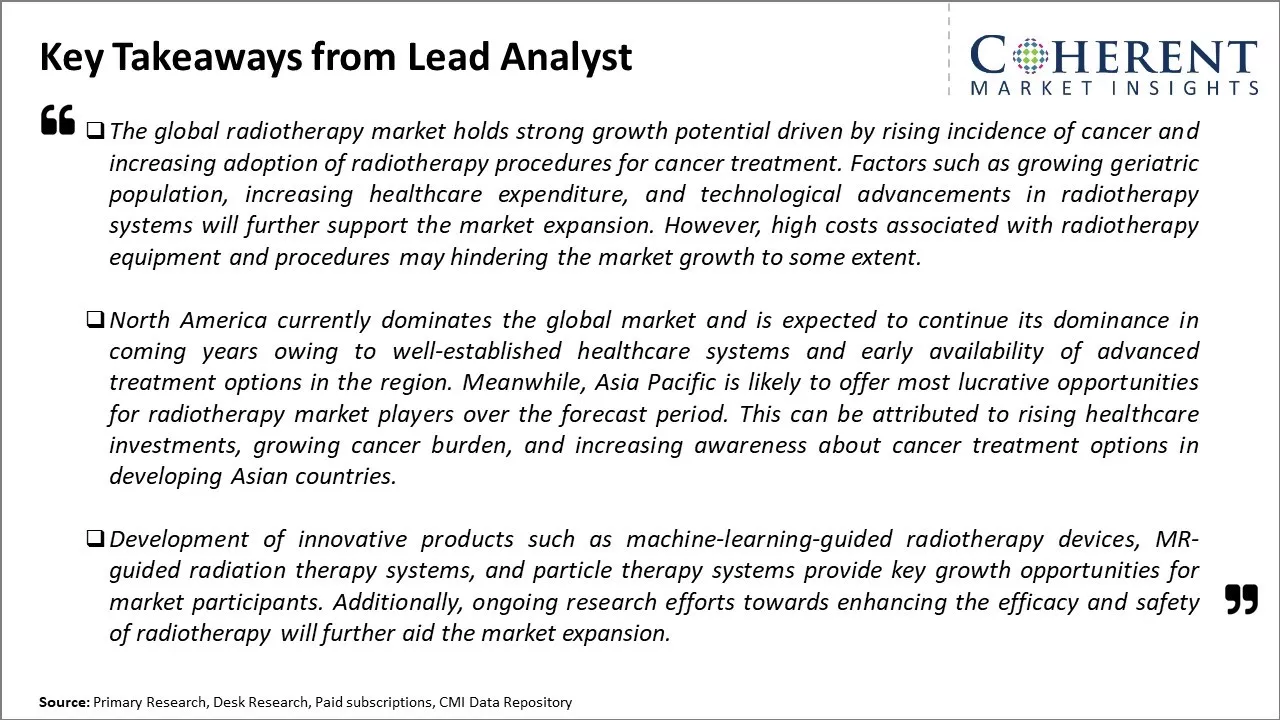
To learn more about this report, Request sample copy
Market Challenges – High Cost of the Radiotherapy DevicesThe major factor that hinders growth of the global radiotherapy market is high cost of radiotherapy devices. For instance, linear accelerator (linac) such as Varian 600CD/6EX, Elekta Precise, and others are priced at a cost ranging from US$ 175,000 to US$ 300,000.
Market Opportunities – Increasing Fundings for Radiation Therapy
Increasing adoption of inorganic growth strategies such as fundings is expected to offer lucrative growth opportunities in the market. For instance, in March 2022, the National Institutes of Health (NIH) granted a funding of US$ 12 million to the Abramson Cancer Center at the University of Pennsylvania, U.S. to study ultra-fast, high-dose FLASH radiation therapy for cancer.
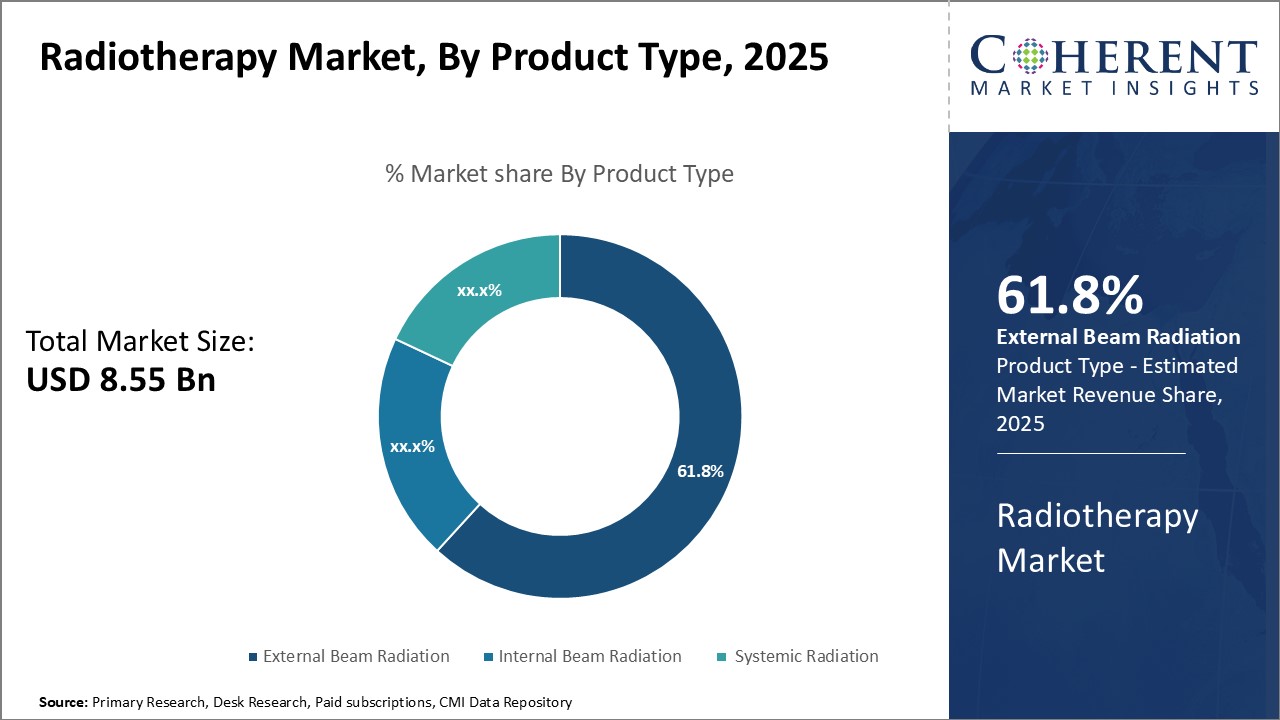
Discover high revenue pocket segments and roadmap to it: Request sample copy
Insights, By Product Type: Driving Advancement in External Beam Radiation Therapy ModalitiesThe product type segment includes external beam radiation, internal beam radiation, and systemic radiation. The external beam radiation sub-segment is estimated to hold 61.8% of the market share in 2025 owing to continuous refinement and the development of external beam radiation therapy modalities over the past few decades. The advent of sophisticated image-guided radiation therapy systems that leverage technologies, such as computed tomography (CT), magnetic resonance imaging (MRI), Positron emission tomography (PET) scanning, and linear accelerators, has improved precision and targeting capabilities for external beam treatments. Additionally, the emergence of highly conformal modalities such as intensity-modulated radiation therapy (IMRT) and volumetric modulated arc therapy (VMAT) allow for better dose distribution and sparing of surrounding healthy tissues. Advancements have also made it possible to deliver higher radiation doses in fewer treatment sessions through techniques like stereotactic body radiation therapy (SBRT). This has translated to better treatment outcomes and patient convenience. Going forward, newer external beam modalities under research promise even higher levels of customization and accuracy to meet the needs of a diverse patient pool. Widespread availability and proven benefits relative to other segments continue to spur growth in the external beam radiation segment.
Insights, By Therapy Type: Expanding Applications of Radiation Therapy
The therapy type segment includes external beam radiation therapy, internal beam radiation therapy, and systemic radiation therapy. The external beam radiation therapy sub-segment is estimated to hold 47.7% of the market share in 2025 due to its diverse applicability across cancer sites. Traditionally used to treat primary tumors, external beam radiation is increasingly being leveraged in adjuvant, neoadjuvant, and salvage settings. It is often combined with chemotherapy to achieve enhanced locoregional control. Additionally, advancements in delivery techniques now allow safer delivery of ablative radiation doses through hypo fractionated regimens for oligometastatic diseases. Emerging data also indicates the potential of post-operative radiation to further reduce the risk of recurrence in high-risk cancer types. These expanding indications across the cancer care continuum have continued to drive the demand for external beam radiation therapy solutions and services.
Insights, By End User: Central Role of Hospitals in Cancer Care
The end user segment includes hospitals, oncology clinics, and ambulatory radiotherapy centers. The hospitals sub-segment is estimated to hold 51.8% of the market share in 2025 owing to their central role in comprehensive cancer care. Most hospitals are equipped with advanced radiology departments housing the latest external beam radiation therapy systems. They also boast well-staffed teams of radiation oncologists, medical physicists, dosimetrists, and nursing personnel with clinical expertise to handle the complexities of radiation treatment planning and delivery. Moreover, the colocation of radiotherapy within hospitals facilitates crucial multidisciplinary collaboration with surgical oncologists, medical oncologists and other specialists to arrive at optimal coordinated treatment strategies. Lastly, hospitals provide a 'one stop shop' for cancer patients requiring additional services under one roof like PDT, chemotherapy, palliative care etc. These attributes cement the position of hospitals as the preferred setting for radiotherapy procedures.
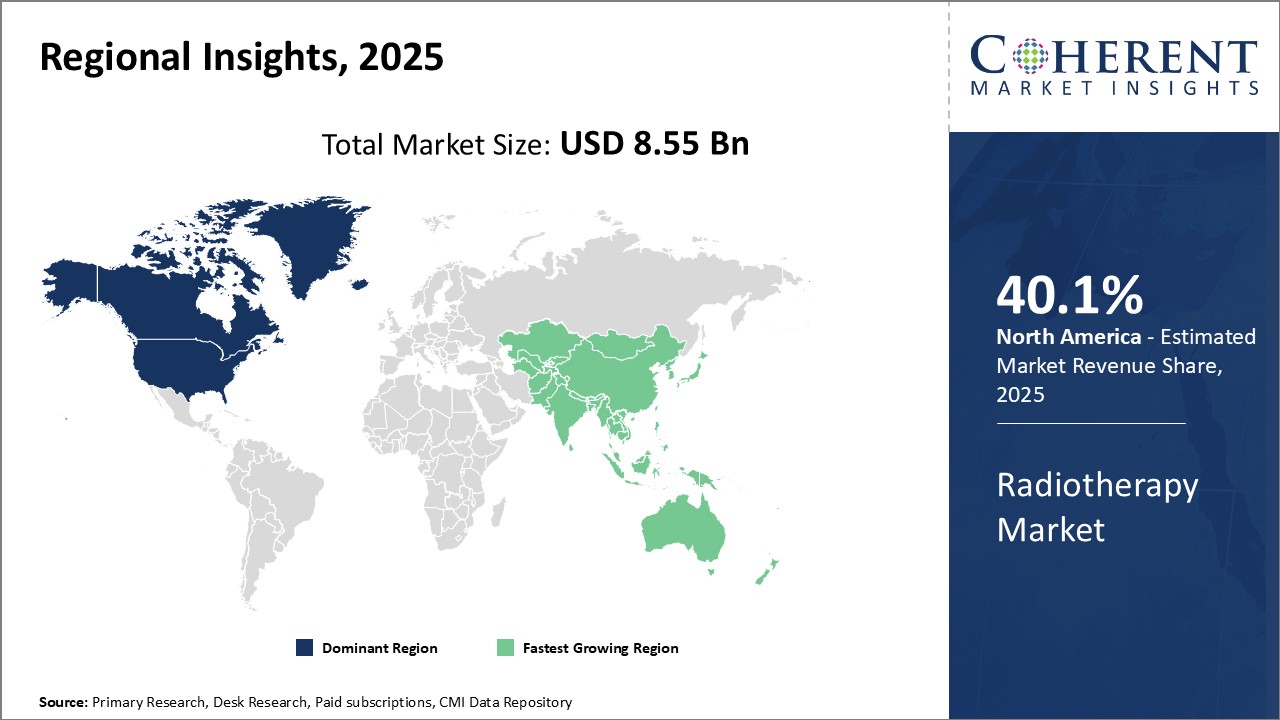
Need a Different Region or Segment? Customize now
North America remains the dominant region in the global radiotherapy market and is estimated to hold 40.1% of the market share in 2025 owing to a well-established healthcare infrastructure and strong presence of industry players in the region. The U.S. alone accounts for over 40.5% of the total market share due to high adoption of advanced treatment devices such as proton therapy systems, and brachytherapy products among other hospitals and cancer care centers. Moreover, favorable reimbursement policies for diagnostic imaging and cancer treatment procedures have further driven the market growth.
Asia Pacific region has emerged as the fastest growing market. Countries like China, India, Japan, and South Korea are witnessing rapid economic development which is improving access to advanced healthcare facilities. Rising healthcare expenditure, growing public awareness about cancer treatment options, increasing geriatric population base are some of the key factors fueling the Asia Pacific radiotherapy market. The market is witnessing higher imports from global majors to meet the domestic demand. Many global original equipment manufacturers (OEMs) have also set up manufacturing bases or entered into partnerships with local players in high potential countries. This has ensuring steady supply of devices and making them more affordable. As the availability of technologically sophisticated products increases in the region, more patients are opting for advanced radiation therapy procedures.
Radiotherapy Market Report Coverage
| Report Coverage | Details | ||
|---|---|---|---|
| Base Year: | 2024 | Market Size in 2025: | USD 8.55 Bn |
| Historical Data for: | 2020 To 2024 | Forecast Period: | 2025 To 2032 |
| Forecast Period 2025 to 2032 CAGR: | 7.3% | 2032 Value Projection: | USD 14.01 Bn |
| Geographies covered: |
|
||
| Segments covered: |
|
||
| Companies covered: |
Accuray Incorporated, Elekta , Isoray Inc., CIVCO, Hitachi, Ltd., Mevion Medical Systems , ProTom International, VIEWRAY TECHNOLOGIES, INC., Panacea Medical Technologies Pvt. Ltd., Optivus Proton Therapy, Inc., RefleXion, MacroMedics, Vision RT Ltd., and Qfix |
||
| Growth Drivers: |
|
||
| Restraints & Challenges: |
|
||
Uncover macros and micros vetted on 75+ parameters: Get instant access to report
*Definition: Radiotherapy, also known as radiation therapy, uses ionizing radiations that deliver targeted beams of radiation to kill and destroy cancer cells. The advanced technology used in radiotherapy works by bombarding cancerous cells with radiation to kill them, while minimizing damage to the healthy cells around them. Radiotherapy is the most potent and cost-effective treatment for cancer, and when integrated with advanced technologies, such as image guided therapy, it leads to enhanced control over tumor and toxicity.
Share
Share
About Author
Manisha Vibhute is a consultant with over 5 years of experience in market research and consulting. With a strong understanding of market dynamics, Manisha assists clients in developing effective market access strategies. She helps medical device companies navigate pricing, reimbursement, and regulatory pathways to ensure successful product launches.
Missing comfort of reading report in your local language? Find your preferred language :
Transform your Strategy with Exclusive Trending Reports :
Frequently Asked Questions
Joining thousands of companies around the world committed to making the Excellent Business Solutions.
View All Our Clients
US Reciprocal Tax Impact Analysis On Radiotherapy Market
Stay updated on tariff changes with expert insights and timely information